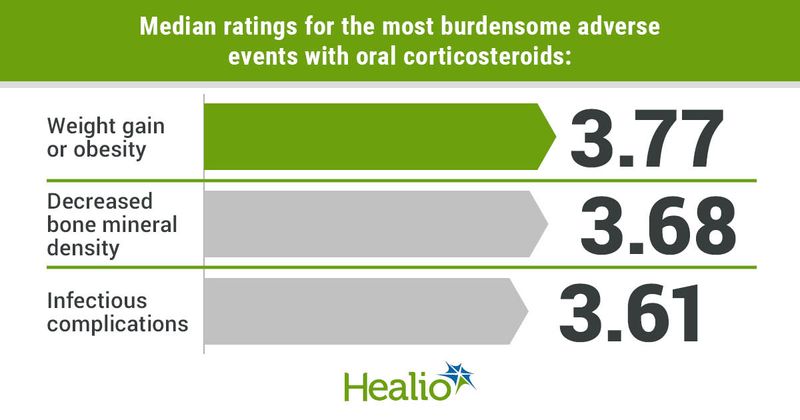Oral, inhaled corticosteroids impose multiple burdens on quality of life in asthma
Key takeaways:
- Pneumonia, hoarse voice and oral thrush were the greatest burdens with inhaled corticosteroids.
- Patients also reported social stigmas associated with using inhaled corticosteroids.
The most burdensome adverse events that patients with asthma reported when using inhaled and oral corticosteroids did not always cause them to stop therapy, according to a study published in Annals of Allergy, Asthma & Immunology.
Social stigma and psychosocial burdens associated with the use of these medications may limit treatment adherence as well, Vickram Tejwani, MD, assistant professor of medicine at Cleveland Clinic Lerner College of Medicine/Case Western University School of Medicine, and Respiratory Institute of Cleveland Clinic, and colleagues wrote.

“Asthma quality of life has been recognized as an important outcome to clinicians, investigators, payers and patients,” Tejwani told Healio.

“However, current measures typically do not account for adverse effects of asthma therapies, specifically the mainstays of inhaled and oral corticosteroids,” he continued. “Our study sought to utilize quantitative and qualitative measures to better understand these adverse effects.”
Study design, results
The study involved a quantitative survey conducted between February and April 2020, as well as qualitative interviews and virtual focus groups conducted between March and June 2021.
The 124 respondents to the survey included 81% aged 35 and 74 years, 85% who were cisgendered women and 95% with a diagnosis of asthma, with 78% who lived in the United States and 22% who lived in the United Kingdom.
These respondents also included 82 who reported short courses of oral corticosteroids (OCS) of 30 days or less in the previous 12 months, 42 who reported long courses of more than 30 days, and 105 who reported daily use of inhaled corticosteroids (ICS).
Using a 5-point scale, with higher scores indicating greater burdens, the mean ratings of the most burdensome adverse events associated with OCS of the 25 included in the survey included 3.77 for weight gain or obesity, 3.68 for decreased bone mineral density and 3.61 for infectious complications.
The least burdensome adverse events associated with OCS included elevated blood pressure with a mean rating of 2.73, skin effects with a mean rating of 2.62, and diarrhea with a mean rating of 2.39.
Mean ratings for the most burdensome adverse events associated with ICS included 3.19 for pneumonia, 3.14 for hoarse voice and 3.09 for oral thrush. The least burdensome adverse events associated with ICS included cough with inhalation (2.46), tongue enlargement (2.42) and nose bleeds (2.39).
When respondents were asked which adverse events they would eliminate, they most often chose weight gain or obesity, decreased bone density and sleeplessness for OCS and pneumonia, hoarse voice and oral thrush for ICS.
The three focus groups included five participants with moderate to severe asthma each and lasted for 2 hours. Discussions focused on mental health and emotional wellness, treatment satisfaction and access to care, physical health and functioning, and impact on daily life/lifestyle and financial well-being.
The researchers noted that there were no direct questions about steroid use, but participants still discussed their experiences with OCS and ICS.
The patients who used OCS indicated that the biological and physical effects of the medication such as weight gain and poor sleep were the predominant burdens. The patients who used ICS were primarily concerned with the social stigma associated with the medication, such as embarrassment when using it in front of others.
Tejwani called these psychosocial consequences including aversion to inhaler use surprising and significant, as physicians typically do not recognize them and counsel patients about them during discussions of the adverse effects of medications.
Conclusions, next steps
The researchers attributed these differences between the focus on somatic adverse events with ICS use in the quantitative survey and on psychosocial burdens in the focus groups partly to the importance that heath care providers place on somatic adverse events, with a wide range of interventions to treat them compared with the lack of choices for treating the psychosocial adverse events.
Further, the researchers wrote, the psychosocial effects of inhalers are known but not widely studied, with few studies investigating how their social stigmas may be mitigated or how these stigmas impact medication adherence. Yet these findings indicate that these psychosocial effects matter to patients even though health care providers do not recognize them enough, according to the researchers.
The somatic effects of OCS were prevalent in the quantitative data and an emergent theme in the qualitative data as well, the researchers found, with both indicating the continued importance of developing therapies that minimize reliance on these medications and their impact on quality of life.
Although these burdens interfere with medication adherence, the researchers continued, other obstacles include medication costs, access to providers, disease unpredictability and comorbid mental health conditions, adding to poor adherence rates.
Future studies should aim to determine which adverse events deter patients from using their steroids, which patients are most at risk, and how these effects can be minimized to enhance adherence and improve outcomes, the researchers wrote.
Additional research should use qualitative work to better characterize the overall burden of asthma, including the adverse effects of medications and other psychosocial and socioeconomic factors such as financial toxicity as well, Tejwani said.
Also, Tejwani said that physicians should express empathy for patients and awareness of the side effects of oral and inhaled corticosteroids.
“Emphasize that although we are aware of these adverse effects, the risks are still outweighed by the benefit of their asthma control,” Tejwani said. “Also, acknowledge the impact of inhaler use on their social interactions (eg, disruption and removal from social situations) and review mitigating factors as able.”
For more information:
Vickram Tejwani, MD, can be reached at tejwanv@ccf.org.
